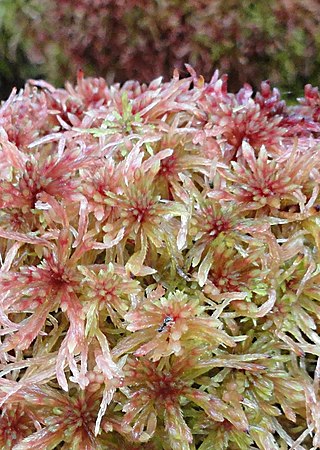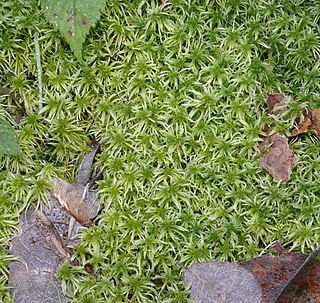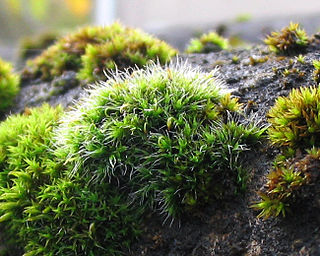
Pleurozium schreberi, the red-stemmed feathermoss or Schreber's big red stem moss, is a moss with a loose growth pattern. The root name pleuro comes from the Latin for ribs, possibly describing how the parts branch from the stem.
Rhytidiadelphus triquetrus, the big shaggy-moss or rough goose neck moss, is a species of moss in the family Hylocomiaceae. It is often the dominating moss species in moderately rich forest habitats in the boreal regions and the Pacific Northwest. Because of its fuzzy appearance and tail-like shape it is also called the 'electrified cat's tail moss'. Not to be confused with square goose-necked moss, Rhytidiadelphus squarrosus.

Helodium blandowii, also known as Blandow's helodium moss, Blandow's tamarisk-moss, Blandow's bogmoss, and Blandow's feathermoss, is a rare plant in the Western U.S., including Oregon and California. It occurs all around the northern hemisphere in higher latitudes, and in some places is not as rare as in the Western U.S.
Tayloria lingulata, commonly known as lingulate dung moss, tongue-leaved gland-moss, or marsh collar-moss, is a moss found in montane habitats in the Northern Hemisphere including Europe, Asia and North America.

Plagiomnium medium, commonly known as Alpine thyme-moss or intermediate plagiomnium moss, is a moss found in montane habitats in the Northern Hemisphere.

Sphagnum angustifolium, the fine bogmoss, is a species of peat moss with a Holarctic distribution.

Sphagnum russowii, Russow's sphagnum or Russow's bogmoss, is a species of peat moss with a Holarctic distribution.

Sphagnum girgensohnii, also known as Girgensohn's bogmoss, Girgensohn's sphagnum or common green peat moss, is a species of peat moss with a Holarctic and Indo-Malesian distribution.

Ptilium crista-castrensis, the knights plume moss or ostrich-plume feathermoss, is a moss species within the family Pylaisiaceae, in the class Bryopsida, subclass Bryidae and order Hypnales.

Bartramia halleriana, the Haller's apple-moss or Haller's bartramia moss, is a species of moss in the family Bartramiaceae.

Sphagnum palustre, the prairie sphagnum or blunt-leaved bogmoss, is a species of peat moss from the genus Sphagnum, in the family Sphagnaceae. Like other mosses of this type it can soak up water up to the 30-fold amount of its own dry weight thanks to its elastic spiral fibers. S. palustre is rather frequent and is spread almost all over the world. It mainly grows in wet forests and—compared to other specimens of this genus—rarely grows in moors.

Polytrichum juniperinum, commonly known as juniper haircap or juniper polytrichum moss, is an evergreen and perennial species of moss that is widely distributed, growing on every continent including Antarctica.

Splachnum sphaericum, also known as pinkstink dung moss, is a species of moss. This species occurs in North America. It also occurs in upland Britain, where it is known as round-fruited collar-moss and in north temperate and boreal regions of Europe. Its habitat is bog and wet heathland where it grows on herbivore dung. This and other Splachnum species are entomophilous. The sporophytes, which are generally coloured red or black, produce an odour of carrion that is attractive to flies and the spores are dispersed by flies to fresh dung.

Tortula acaulon, formerly Phascum cuspidatum, the cuspidate earth-moss or toothed phascum moss, is a moss with 3 mm leaves which forms green patches. It is very common and has a number of varieties in a wide range of habitats. The variety piliferum occurs on sandy soils near the sea.

Plagiomnium affine, the many-fruited thyme-moss, is a species of thyme-moss found in old-growth boreal forests in North America, Europe and Asia, growing in moist, but not wet, basic to slightly acidic micro-habitats in woodland and in turf.

Calliergon giganteum, the giant spearmoss, giant calliergon moss, or arctic moss, is an aquatic plant found on lake beds in tundra regions. It has no wood stems or flowers, and has small rootlets instead of roots.

Grimmia pulvinata, otherwise known as grey-cushioned grimmia or pulvinate dry rock moss, is a bryophyte moss common in temperate climates worldwide.

Bryum turbinatum, also known as topshape thread-moss or pear-fruited bryum, is a species of moss found in continental Europe and the US. The species became extinct across the British Isles in the 1940s according to the Species Recovery Trust and in 2001 according to the IUCN, and it has not reestablished since.

Mnium is a genus of mosses belonging to the family Mniaceae. The species of this genus are found in Europe and North America.

















